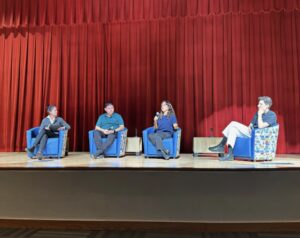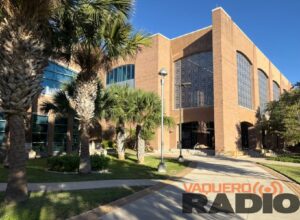
The leadership team for UTRGV’s RESCUE project includes (from left) Can Saygin, principal investigator; Jianzhi (James) Li, co-principal investigator; Cecilio Ortiz García, co-principal investigator; and Ron Garza, co-principal investigator. (Photo by Jesús Alférez)
A group of UTRGV researchers is working on a project that may be able to help eliminate or minimize the disruptions related to the energy grid fragility in the Rio Grande Valley.
The University of Texas Rio Grande Valley project RESCUE is a finalist for the Gulf of Futures Challenge, which is a competitive program from National Academies of Sciences, Engineering and Medicine working along with Lever for Change.
The challenge received 164 applications from organizations in Louisiana, Florida, Alabama, Mississippi and Texas.
From the 164 applications, the competition was narrowed down to 10 finalists. As a finalist, UTRGV will receive $300,000 in planning funds. Two finalists will receive $20 million.
RESCUE stands for Renewable Energy for Sustainable, Continuous, Uninterrupted Ecosystems.
Principal Investigator, Senior Vice President for Research and Dean of the Graduate College Can Saygin said the team would like to bring together the technological components to minimize the Valley’s fear of losing power during a weather disaster.
“And when you look at the region, we are underserved economically, disadvantaged, and given the population and the grid structure,” Saygin said. “There are a lot of outages as you can imagine.”
He said to provide a continuous energy system, the team has to bring in the technology system and the manufacturing of technology. The team is working on a microgrid, which is a battery-energy-storage system.
“It could be fossil fuels, so by basically expecting disruptions, you are basically keeping your battery full with a variety of different energy sources, and that battery energy storage system can actually support the grid,” Saygin said.
Cecilio Ortiz-Garcia is a professor of Public Affairs and Security Studies and director of the Center for Community Resilience Research Innovation and Advocacy, and also serves as the co-principal investigator of the project.
“Renewables, not only are they different technological artifacts, renewable energy technologies, they also change their behaviors,” Ortiz-Garcia said. “They change the culture, and they change their relationships between energy producers, energy users. For example, a household or the owners, a family that owns a house can now not only be a consumer of energy, but a producer of energy as total of energy, and this changes the dynamics, the social dynamics of these energy systems.”
Saygin said the two winners will be announced in January 2026.



